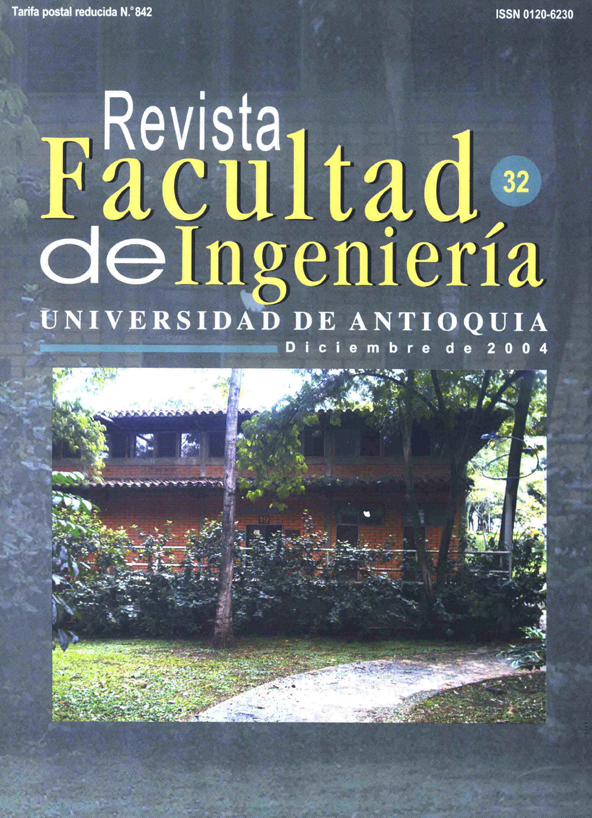Determinaciones coulométricas sobre probetas de cobre expuestas a vapores con bajos contenidos de ácido propiónico
DOI:
https://doi.org/10.17533/udea.redin.344367Palabras clave:
corrosión atmosférica, cobre, ácido propiónico, reducción coulométrica, técnicas electroquímicas, técnicas gravimétricas, métodos coulométricosResumen
En el presente estudio se evaluó el efecto de tres concentraciones de vapor de ácido propiónico (260, 380 y 680 partes por billón en volumen, ppbv) en una corriente de aire a 30 °C y 90% de humedad relativa sobre el deterioro del cobre, mediante la determinación de la carga total requerida para reducir los compuestos formados, utilizando la técnica de la reducción coulométrica según norma ASTM B-825-97. Los ensayos electroquímicos se realizaron para 7, 14 y 21 días de exposición. Además, se hicieron determinaciones gravimétricas a los 21 días de exposición, según norma ASTM G1-90, para comparar la velocidad de corrosión con los resultados electroquímicos. Las exposiciones se realizaron en una cámara climática con controles electrónicos de temperatura y de humedad relativa a un flujo de aire constante de 4 L/min. El contaminante fue agregado al flujo del aire mediante tubos de emisión de ácido propiónico con diferentes aberturas de emisión y certificados gravimétricamente a 2.650, 3.750 y 6.900 ng/min. Los resultados mostraron diferencias estadísticas (con 95% de confiabilidad) para la carga requerida en la reducción total de los óxidos entre los 7 y 21 días de exposición y que ésta también aumenta con el nivel de contaminante, indicando que los productos de corrosión crecen con el tiempo de exposición y con el aumento en la concentración del ácido. Particularmente se encontró que la técnica de reducción coulométrica es más confiable que la gravimétrica para evaluar la velocidad de corrosión en estos ambientes, típicos de atmósferas de muy baja agresividad. En la técnica gravimétrica, la remoción de metal base inherente al proceso de decapado ácido es del mismo orden de magnitud con respecto al de los productos formados en el proceso de corrosión, conduciendo a alta dispersión de los resultados.
Descargas
Citas
Echavarría, A. et al. “Carboxilic acids in the atmosphere and their effect on the degradation of metals”. Corr. Rev. Special Issue: Corrosion Control in the Electronics Industry. N.° 21. 2004. p. 395. DOI: https://doi.org/10.1515/CORRREV.2003.21.5-6.395
Cano, E. and Bastidas J. M. Can. Metall. Quart. N.° 41. 2002. p. 327. DOI: https://doi.org/10.1179/cmq.2002.41.3.327
López Delgado, J. E. et al. “A laboratory study of the effect of acetic acid vapor on atmospheric copper corrosion”. En: J. Electrochem. Soc. N.° 145. 1998. p. 4140. DOI: https://doi.org/10.1149/1.1838928
Bastidas, J. M. et al. J. Electrochem. Soc. N.° 147, 2000. p. 999. DOI: https://doi.org/10.1149/1.1393303
Cano, E. et al. J. Electrochem. Soc. N.° 148, 2001. p. E26. DOI: https://doi.org/10.1149/1.1344547
Echavarría, A. et al. “Copper corrosion originated by propionic acid vapors”. En: J. Electrochem. Soc. N.° 150. 2003. p. B140.7. DOI: https://doi.org/10.1149/1.1559132
Cano, E. et al. “Study of the effect of acetic acid vapors on copper corrosion at 40 and 80% relative humidity”. En: J. Electrochem. Soc. N.° 148. 2001. p. B431. DOI: https://doi.org/10.1149/1.1404968
Cano, E. et al. Corrosion of copper originated by butyric acid vapors. Proc. of the Latincorr 2003. Santiago de Chile, October 20/24, 2003. p. 688.
Cano, E. et al. Proc. of the IX Conference on Materials Science & Technology, 209/CTM 2003.
American Standards for Testing and Materials. ASTM B- 825-97, Standard Test Meted for Coulometric Reduction of Surface Films on Metallic Test Samples.
Krumbein, S. J. et al. J. of Testing and Eval. 1989. p. 357. DOI: https://doi.org/10.1520/JTE11142J
Echavarría, A. et al. “Reducción coulométrica de productos de corrosión del cobre en ambientes de ácido acético y ácido sulfhídrico”. En: Proc. of the Latincorr 2003. Santiago de Chile, October 20/24, 2003. p. 638.
American Standards for Testing and Materials. ASTM G1-90, Standard Practice for Preparing, cleaning and evaluating corrosion test specimens.
José Rocha Andrade da Silva, Editor. CYTED. Productos electro-electrónicos en ambientes tropicales. Campinas, SP, Sitta Grafica. 2003. p. 248.
Descargas
Publicado
Cómo citar
Número
Sección
Licencia
Los artículos disponibles en la Revista Facultad de Ingeniería, Universidad de Antioquia están bajo la licencia Creative Commons Attribution BY-NC-SA 4.0.
Eres libre de:
Compartir — copiar y redistribuir el material en cualquier medio o formato
Adaptar : remezclar, transformar y construir sobre el material.
Bajo los siguientes términos:
Reconocimiento : debe otorgar el crédito correspondiente , proporcionar un enlace a la licencia e indicar si se realizaron cambios . Puede hacerlo de cualquier manera razonable, pero no de ninguna manera que sugiera que el licenciante lo respalda a usted o su uso.
No comercial : no puede utilizar el material con fines comerciales .
Compartir igual : si remezcla, transforma o construye a partir del material, debe distribuir sus contribuciones bajo la misma licencia que el original.
El material publicado por la revista puede ser distribuido, copiado y exhibido por terceros si se dan los respectivos créditos a la revista, sin ningún costo. No se puede obtener ningún beneficio comercial y las obras derivadas tienen que estar bajo los mismos términos de licencia que el trabajo original.










 Twitter
Twitter